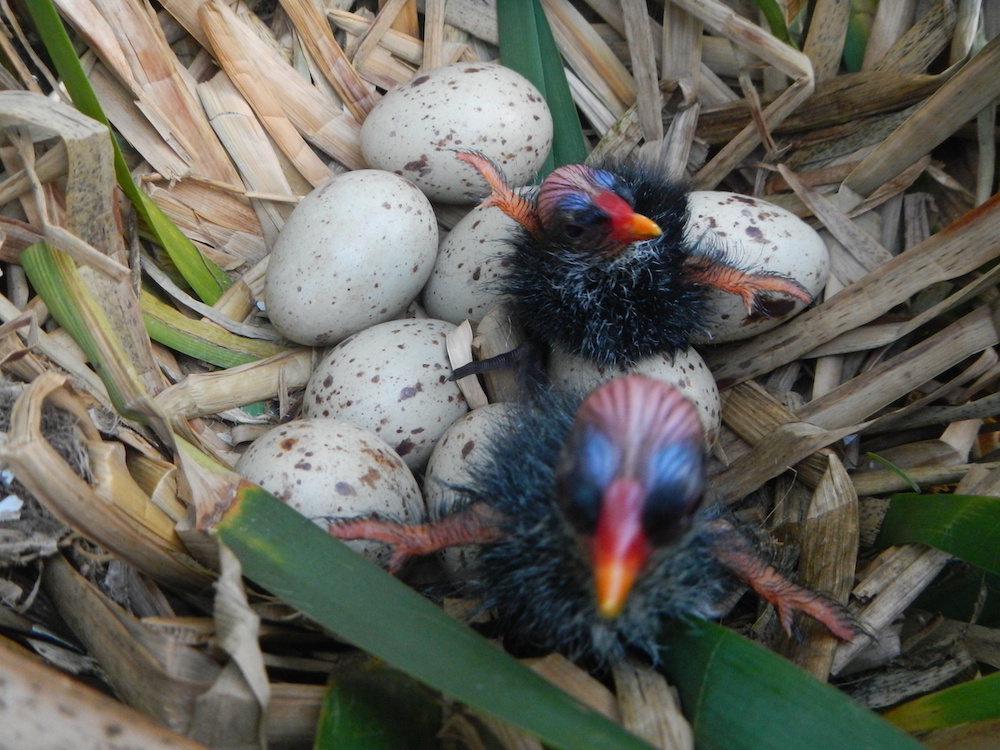
Least bittern chicks. Photo courtesy of Forbes Biological Station.



Least bittern chicks. Photo courtesy of Forbes Biological Station.
In many places around Illinois, and historically along the Illinois River, there are wetlands covered in the summer by cattails and bulrushes, and other annual plants that only grow in aquatic environments. These emergent wetlands, aptly named because the plants emerge from the water, are an important habitat for a wide variety of animals that only live in wetlands. From bitterns to ducks to swans to gallinules, they need wetlands. Least bitterns use cattails as support to build nests that hang like hammocks above the water, while ducks and swans use the vegetation to help hide their young from predators. The presence of water is important, too, because habitat isn’t just something that provides shelter and food, it also helps them stay alive by avoiding predators. Standing water helps birds avoid certain predators, like some mammals that prefer not to swim; wetlands without water, are a more dangerous place for animals to raise their young.

Wetlands are not just important in the summer when birds are nesting, but are habitat for migratory birds as well, such as waterfowl and rails. Virginia rails and sora, both game species in Illinois, rely on wetlands in Illinois as places to stop, rest and refuel on their annual migrations in spring and autumn. They start arriving in August, and peak in September and October, making their migration earlier than most species of ducks. Wetlands with high quality food resources help them to refuel more quickly and be able to complete their migration safely. Often rails and ducks use the same wetlands during migration, as many species of ducks and rails eat the same seeds and use the plants as protection from the elements and predators.
For wetland birds which nest in Illinois, we generally know which species nest in which type of wetland habitat, however, knowledge describing the habits of several state threatened and endangered species is limited, ultimately hindering a land managers’ ability to create the habitat they need. Our research at the Forbes Biological Station, Illinois Natural History Survey on the Emiquon Preserve in Fulton County, has focused on two state threatened and endangered species over the past several years and includes monitoring nests of least bitterns and common gallinules. This work helps us determine which nests successfully produce young, which ones have young or eggs eaten by snakes or other predators, and hopefully characteristics that impact those successes and failures in nesting and brood-rearing.

Least bitterns are medium sized birds with a large bill that helps them in securing their food (e.g., small fish, frogs and large insects), and long legs with large toes that help them grasp and move through the cattails without having to touch the ground. Both male and female are colored with oranges and grays and yellows, and their young look like grumpy old birds, rather than chicks only a few weeks old. Likewise, common gallinules, are medium sized birds, marked by a distinctive red shield that sits between the eyes coming out of the top of the bill. Gallinules often have platform nests built out of live and dead vegetation to keep the nest slightly elevated above the water line.
To find their nests, we walk through the wetlands, slowly searching and scanning the vegetation. Once we locate a nest, we visit it twice weekly until the nest succeeds, and the young leave, or the eggs or young are eaten by a predator. This year, University of Illinois graduate student Stephanie Schmidt is deploying specialized cameras at nest sites to determine specific predators visiting the nests; as of mid-June, it’s mostly fox snakes, sometimes eating only one egg while others the entire clutch.

One aspect of working with poorly studied birds is that often we must expect the unexpected. For instance, common gallinules are thought to build nests on the water surface, or on muskrat mounds, but this summer we have found several nests that were woven up in the cattails, well above the water’s surface. Birds are often more adaptable than we know. As scientists we attempt to put them into categories, but the birds are far more adaptable than that. With more study, we see that they can make choices and do different things, depending on the wetland conditions they encounter. There is much to learn about the birds that rely on Illinois wetlands, and how we can manage for them, along with a multitude of other human and animal needs in these wetlands.
Auriel M.V. Fournier is the Director Forbes Biological Station, Illinois Natural History Survey.
Aaron P. Yetter is a biologist for the Illinois Natural History Survey, Prairie Research Institute.
Joshua M. Osborn is a Wetland Bird Ecologist at the Illinois Natural History Survey Forbes Biological Station at the University of Illinois at Urbana-Champaign.
Submit a question for the author